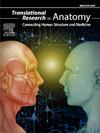The medial plica syndrome of the knee – Narrative review of the literature
Q3 Medicine
引用次数: 0
Abstract
Synovial plicae are physiological tissue found in the knee joint. They are formed in the fetal period as remnants of synovial cavities that are not absorbed in the process of apoptosis. Depending on the location of the plica, medicine distinguishes several types of plicae - suprapatellar, infrapatellar, medial and the lateral one. Based on the shape and size of the fold, the types are divided into subtypes. In the knee joint, the most common is medial plica, which extends from the area of the articular muscle or the vastus medialis oblique muscle, which runs parallel to the medial femoral condyle and patella.
Medial plica syndrome (MPS) is the medical term for the development of sympthoms caused by a pathological synovial fold. A significant factor in the pathophysiology of medial plica syndrome is the stage of inflammation, occurring either in the direct injury mechanism of plica (e.g. torsional mechanism) or as a consequence of cumulative overload changes. Typical clinical symptoms of a patient with MPS include: dull pain in the antero-medial apspect of the knee, associated with repeated knee flexion movement with possible clicking or locking signs. Clinical provocation tests were described (Mediopatellar Plica Test, Hughston Fold Test, Stutter Test) to confirm the diagnosis. It is crucial to exclude the presence of other knee joint diseases.
Imaging including ultrasound and MRI may be useful in differential diagnosis but confirmation of the presence of the plica is not sufficient to make a diagnosis. Conservative treatment can be effective and it is based on NSAIDs administration, activity modification, kinesiotherapy and physical therapy. In the case of ineffective conservative treatment, arthroscopic surgery is considered. Usually larger folds in the MPS require surgical intervention.
求助全文
约1分钟内获得全文
求助全文
来源期刊

Translational Research in Anatomy
Medicine-Anatomy
CiteScore
2.90
自引率
0.00%
发文量
71
审稿时长
25 days
期刊介绍:
Translational Research in Anatomy is an international peer-reviewed and open access journal that publishes high-quality original papers. Focusing on translational research, the journal aims to disseminate the knowledge that is gained in the basic science of anatomy and to apply it to the diagnosis and treatment of human pathology in order to improve individual patient well-being. Topics published in Translational Research in Anatomy include anatomy in all of its aspects, especially those that have application to other scientific disciplines including the health sciences: • gross anatomy • neuroanatomy • histology • immunohistochemistry • comparative anatomy • embryology • molecular biology • microscopic anatomy • forensics • imaging/radiology • medical education Priority will be given to studies that clearly articulate their relevance to the broader aspects of anatomy and how they can impact patient care.Strengthening the ties between morphological research and medicine will foster collaboration between anatomists and physicians. Therefore, Translational Research in Anatomy will serve as a platform for communication and understanding between the disciplines of anatomy and medicine and will aid in the dissemination of anatomical research. The journal accepts the following article types: 1. Review articles 2. Original research papers 3. New state-of-the-art methods of research in the field of anatomy including imaging, dissection methods, medical devices and quantitation 4. Education papers (teaching technologies/methods in medical education in anatomy) 5. Commentaries 6. Letters to the Editor 7. Selected conference papers 8. Case Reports
 求助内容:
求助内容: 应助结果提醒方式:
应助结果提醒方式:


